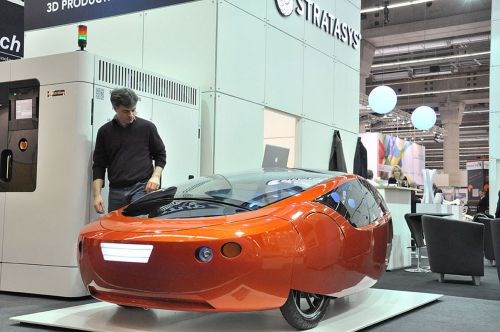Driving Change, Layer by Layer
A vehicle currently in development will not only have a body produced entirely via additive manufacturing processes, but also promises to break new ground in fuel efficiency.

The idea of an environmentally friendly car that is also affordable, practical and capable of being produced with real-world technology might seem far-fetched. However, if all goes according to plan, Jim Kor and his team at Kor Ecologic could do a great deal to lay that view to rest—and additive manufacturing technology is playing a critical role in their efforts.
In 2011, this small company in Winnipeg, Manitoba unveiled the Urbee (urban electric with ethanol as backup), a two-seater hybrid-electric vehicle. Just a few weeks ago, the firm announced that it and its partners—Red Eye on Demand, a rapid prototyping and direct digital manufacturing service, and Red Eye's parent company, additive manufacturing technology supplier Stratasys—had started development of the next-generation Urbee 2, which promises to take the concepts behind the original to a higher level.
What's special about the Urbee? For one, it's fuel-efficient. The plan is to set a new world record by driving from San Francisco to New York on only 10 gallons of biofuel. It will also be no slower than the average vehicle, with highway speeds of 70 mph. Finally, and perhaps most importantly, it will have a relatively simple design. Whereas typical cars contain hundreds of parts, only 40 comprise the Urbee, and the entire car body will be produced via fused deposition modeling on Stratasys machines. "Product design is nearly unencumbered by considerations on how parts can be made with digital manufacturing," Mr. Kor says. "That liberation is incredibly powerful and holds a lot of potential for the future of manufacturing."
Related Content
-
8 Cool Parts From Formnext 2024: The Cool Parts Show #78
End-use parts found at Formnext this year address various aspects of additive's advance, notably AM winning on cost against established processes.
-
Video: AM for Harder, Longer-Lasting Brake Discs
Additive manufacturing is being applied to limit automotive brake dust. For a major automaker, Etxetar and Talens are developing a production-speed directed energy deposition system to give brake discs a precise layer of wear-resistant carbide.
-
A Tour of The Stratasys Direct Manufacturing Facility
The company's Belton manufacturing site in Texas is growing to support its various 3D printing applications for mass production in industries such as automotive and aerospace.











